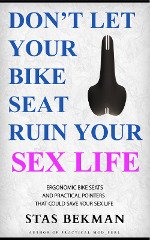8b.24 Measuring the circumference of a wheel
Description
This article is from the Bicycles FAQ, by Mike Iglesias with numerous contributions by others.
8b.24 Measuring the circumference of a wheel
From: Jobst Brandt <jobst.brandt@stanfordalumni.org>
For accuracy, the speedometer wants to know how far the bicycle
travels per wheel revolution (under normal load and inflation).
Therefore, that is what must be measured, and it is commonly called
the "rollout distance". To make this measurement, sit on the bicycle
in typical riding position next to a wall for support, and roll
forward, starting with the valve stem exactly at the bottom at a mark
on the floor. When the stem is again exactly at the bottom, measure
the distance traveled. Typically this distance, for a 700-28 tire at
120 lbs pressure, can be as much as 30 mm shorter under load than
rolling the unloaded wheel for one revolution.
Continue to:

